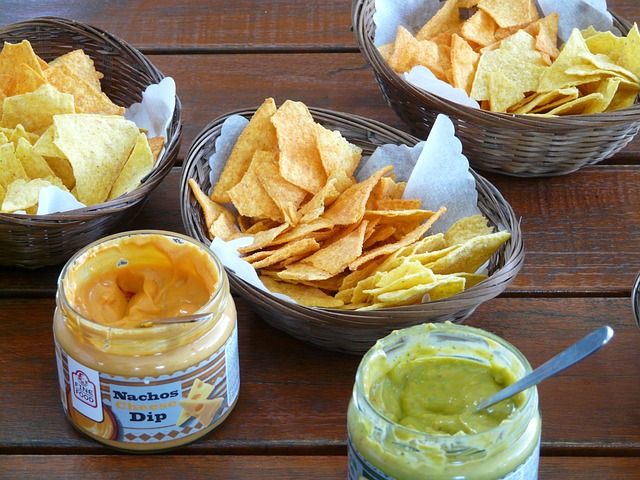The history of restaurant-style tortilla chips began in the 20th century as American restaurants sought diverse snack options, leading to advancements in food processing technology. Wrigley Field's introduction of these premium snacks reflects a broader trend, showcasing their commitment to enhancing guest experiences through quality food. The art and science behind achieving perfect crispness involve selecting premium tortillas, mastering heat control, and refining techniques for consistent results. With a booming demand in the culinary market, manufacturers are creating portable, flavorful chips that replicate restaurant-quality while offering healthier alternatives using superior ingredients and advanced production methods. The mission is to bring the restaurant experience home, balancing natural ingredients with commercial needs, and addressing health concerns by providing nutritious options without compromising on taste.
“Discover the crispy, golden delight that is Wrigley Field’s signature snack—restaurant-style tortilla chips. This article delves into the history of these popular treats, exploring their rise from culinary side dish to baseball stadium staple. We’ll navigate the science behind their crispiness and uncover the secret to their widespread appeal.
From ingredient choices to health considerations and pairing suggestions, we’ll guide you through everything you need to know about restaurant-style tortilla chips, all while uncovering the mission to deliver high-quality snacks that enhance every crunch.”
- The History of Restaurant-Style Tortilla Chips
- Wrigley Field: More Than Just a Baseball Stadium
- The Science Behind Crispy Tortilla Chips
- Exploring the Popular Demand for High-Quality Chips
- Unpacking the Ingredients: Natural vs. Processed
- Health Benefits and Considerations
The History of Restaurant-Style Tortilla Chips

The history of restaurant-style tortilla chips is a fascinating journey that began as a mission to recreate the authentic, crispy texture and taste of hand-made Mexican tortillas. In the early 20th century, American restaurants sought to offer their patrons a more diverse and appealing snack option beyond the traditional potato chip. Inspired by the popular corn tortillas from Mexico, they set out to create an equivalent that could be mass-produced while retaining its crispiness and flavorful crunch.
This quest led to significant advancements in food processing technology. Manufacturers began experimenting with different ingredients and techniques to achieve the perfect balance of texture and taste. The use of specific types of corn flour and precise cooking methods resulted in a chip that was both lighter and crispier than its predecessors, while still managing to capture the essence of restaurant-style tortilla chips—a mission that has since become synonymous with snacking pleasure.
Wrigley Field: More Than Just a Baseball Stadium

Wrigley Field, home of the Chicago Cubs, is more than just a baseball stadium; it’s an iconic landmark that embodies the spirit of the city. Beyond hosting thrilling games and fostering a vibrant fan culture, Wrigley Field has evolved to offer a diverse range of experiences. Among these, the popular restaurant-style tortilla chips have become a beloved treat for visitors. Crafted with care, these crispy tortilla chips are not just a snack but a reflection of the stadium’s commitment to quality and its mission to enhance every guest’s experience.
The introduction of restaurant-style tortilla chips at Wrigley Field underscores the venue’s ongoing efforts to cater to diverse tastes and preferences. These chips, made from premium ingredients, add a touch of local flavor to the baseball experience, ensuring that fans leave satisfied and eager for more. The strategy aligns with the stadium’s broader mission to create memorable moments and foster lasting connections with its visitors, making Wrigley Field a must-visit destination not just for baseball enthusiasts but for food lovers as well.
The Science Behind Crispy Tortilla Chips

The secret behind crispy, golden-brown tortilla chips lies in a delicate balance of art and science. The process begins with selecting high-quality corn tortillas, which are then cut into uniform shapes, ensuring even cooking. Heat plays a crucial role; the right temperature allows for a rapid Maillard reaction, resulting in that desirable crispness without burning. This precise heating technique is akin to how professional chefs achieve perfectly crispy fries or baked goods.
Restaurant-style tortilla chips aim to replicate the satisfying crunch and taste often found in culinary hotspots. By controlling factors such as oil depth, frying time, and seasoning, manufacturers can create chips with a restaurant-quality texture and flavor. The Mission, for instance, is known for its consistent, crispy texture, achieved through years of refining this very science, ensuring each chip provides an indulgent experience.
Exploring the Popular Demand for High-Quality Chips

In today’s culinary landscape, the demand for high-quality, restaurant-style tortilla chips has been steadily rising. Consumed across various settings, from casual gatherings to fine dining establishments, crispy tortilla chips have become a ubiquitous side dish or snack option. This trend reflects consumers’ growing appreciation for authentic, flavorful snacks that deliver on texture and taste.
The mission behind many chip brands, including those aimed at Wrigley Field, is to capture the essence of restaurant-quality chips in convenient, portable forms. By utilizing premium ingredients and meticulous production techniques, these chips strive to offer a consistent, enjoyable experience that satisfies the diverse palates of today’s snack enthusiasts. The popularity of this pursuit lies not only in the quest for better taste but also in the desire for healthier alternatives without compromising on crispiness or flavor.
Unpacking the Ingredients: Natural vs. Processed

When it comes to restaurant-style tortilla chips, achieving that perfect crispy texture and satisfying crunch is an art. Uncovering the ingredients behind this snack reveals a fascinating interplay between natural and processed elements. On one hand, traditional methods involve using simple, organic ingredients like corn, salt, and vegetable oils extracted through careful refining processes. These natural components form the foundation of authentic tortilla chips, ensuring a healthier alternative for those discerning eaters.
On the other hand, many commercial brands incorporate highly refined vegetable oils and various additives to extend shelf life and enhance taste. While this approach ensures consistent quality and availability, it may come at the cost of nutritional value. The restaurant-style tortilla chip’s mission lies in striking a balance between these two worlds; offering consumers a crispy, flavorful snack that caters to their cravings without compromising on quality or health considerations.
Health Benefits and Considerations

Restaurant-style tortilla chips, like those found at Wrigley Field, are a popular snack loved for their crispy texture and savory taste. While they’re often enjoyed as a casual treat, it’s important to consider their health implications. These chips, typically made from corn or wheat flour, can be high in calories, unhealthy fats, and sodium, contributing to weight gain and other health issues if consumed excessively. However, when enjoyed in moderation, they can also offer some nutritional benefits. Corn tortillas, for instance, are a good source of fiber and certain vitamins and minerals, depending on the ingredients used.
The mission of many chip manufacturers, including those aiming to replicate restaurant-style flavors, is to create options that are both delicious and healthier. This often involves using whole grains, reducing unhealthy fats, and offering lower-sodium varieties. Opting for these alternatives can help snack lovers enjoy their favorite crispy treats while maintaining a balanced diet.
The journey of restaurant-style tortilla chips, from their humble origins to becoming a staple at baseball stadiums like Wrigley Field, showcases a blend of cultural evolution and scientific innovation. As consumer demand for high-quality chips continues to rise, understanding the science behind their crispiness and exploring healthier alternatives becomes paramount. By delving into natural vs. processed ingredients and considering health benefits, consumers can make informed choices while appreciating the rich history and future prospects of these beloved snacks, aligning with the mission of providing restaurant-quality experiences at home.
